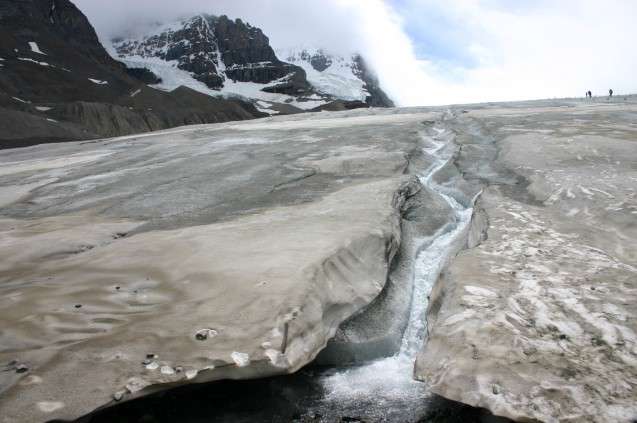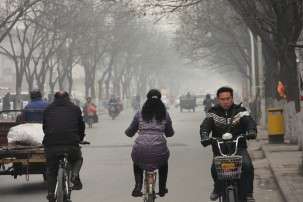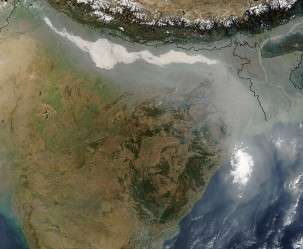The melting toe of the Athabasca Glacier in Canada. Credit: Wing-Chi Poon
Air pollution, both outdoors and indoors, causes millions of premature deaths each year. The deaths are mainly caused by the inhalation of particulate matter. Black carbon, a component of particulate matter, is especially dangerous to human health because of its tiny size. But black carbon not only has impacts on human health, it also affects visibility, harms ecosystems, reduces agricultural productivity and exacerbates global warming.
The World Health Organization's new report on disease from preventable environmental risks attributes 3.7 million premature deaths in 2012 to outdoor air pollution, and 4.3 million to household air pollution. The breathing in of particulate matter (composed of black carbon, sulfate, nitrates, ammonia, sodium chloride, mineral dust and water) that measures 10 microns or less in diameter (PM10), poses the greatest health risks because the particles can find their way deep into lungs and the bloodstream, and cause cardiovascular and respiratory disease, and premature death. Formed by the incomplete burning of fossil fuels, biofuels and biomass, black carbon, has a diameter of less than 2½ microns (PM2.5).
A major constituent of soot, black carbon is the most solar energy-absorbing component of particulate matter and can absorb one million times more energy than CO2. The amount of energy stored in the atmosphere is measured as watts per square meter of Earth's surface; a 2013 study estimated black carbon's effect to be 1.1 watts per square meter per year, second only to carbon dioxide, which is responsible for 1.56 watts per square meter. In other words, black carbon is the second largest contributor to climate change after CO2. But unlike CO2, which can stay in the atmosphere for hundreds to thousands of years, black carbon, because it is a particle, remains in the atmosphere only for days to weeks before it returns to earth with rain or snow.
Air pollution in Anyang, China. The most harmful air pollution is PM2.5. Credit: V.T.Polywoda
Because black carbon absorbs solar energy, it warms the atmosphere. When it falls to earth with precipitation, it darkens the surface of snow and ice, reducing their albedo (the reflecting power of a surface), warming the snow, and hastening melting.
Black carbon, like all particles in the atmosphere, also affects the reflectivity, stability and duration of clouds and alters precipitation. Depending on how much soot is in the air and where black carbon sits in the atmosphere, it has different effects. If it absorbs heat at the level where clouds are forming, they will evaporate. When it lies above lower stratocumulus clouds that block the sun, it stabilizes them and thus has a cooling effect. Because black carbon interacts with other components of particulate matter, such as sulfates and nitrates that reflect sunlight and cool the atmosphere, scientists do not know exactly how much black carbon itself directly contributes to global warming.
The United States is responsible for about 8 percent of global black carbon emissions, with most of it coming from diesel engines, biomass burning, including wildfires, residential heating and industry. Developing countries in Asia, Africa and Latin America emit more than 75 percent of global black carbon emissions, mainly from cookstoves and the burning of solid fuels like coal and wood for heating, which especially affects the health of women and girls. Diesel vehicles and open biomass burning, the largest global source of black carbon, also contribute significant emissions.
Snow covered regions are the most vulnerable to the warming effects of black carbon, and any particles reaching them are of concern if they are darker than snow, because they can reduce reflectivity and speed melting. Glaciers are melting in the Andes, the Rocky Mountains, the Canadian Rockies, the Alps, the Himalayas and around the world. As glaciers melt and retreat, the ice melt that during the dry season feeds the rivers that supply irrigation systems will dwindle. The glaciers of the Himalayas and the Tibetan Plateau sustain the rivers of China and India and are critical to the fresh water and food supplies of these two countries.
As arctic ice continues to melt, there will be more shipping in the region, making it more likely that black carbon emissions from ships burning heavy fuel will increase in the future.
According to the Committee on the Marine Transportation System, shipping in U.S. waters of the arctic could increase five-fold by 2025.
A new study found that Greenland's ice and snow have been darkening over the last 20 years, and it's expected that its albedo could decrease 10 percent or more by the end of the century. The study used satellite data to compare summertime changes in Greenland's albedo from 1981 to 2012.
Marco Tedesco, a Lamont-Doherty Earth Observatory research professor, adjunct scientist at NASA Goddard Institute of Space Studies and lead author of the study, explained that soot, dust, bacteria and algae are present on the ice and snow, transported there by rain or snow. They sit on the ice sheets, and are concentrated on the surface by the increased melting.
Haze over northern India, mostly from biomass burning and urban air pollution. Credit: NASA
"The melting releases all the dark particles stored in the snow pack," said Tedesco. "Some is washed away with the water, but 20 to 30 percent, to the best of our knowledge, stays on the surface of the ice or snow as melting continues."
Tedesco and his colleagues took into consideration the potential impact of soot from forest fires in China, Siberia and North America, but found no statistically significant increase of it between 1996 and 2012 that corresponded to Greenland's darkening. The increased darkening they discovered did not come from black carbon in the atmosphere, but from what was already stored in the snowpack. "When melting increases so quickly as it happened over the past 20 years, what's stored in the snowpack matters more than what comes from the atmosphere because of the melting speed," said Tedesco.
The process is intensified because as snow melts and refreezes, the meltwater sticks grains of snow together. As snow grains get bigger, more solar radiation is absorbed, increasing melting and exposing more darkening. This process, however, is invisible to our eye—the light reflecting off the snow may look the same, however the absorption and darkening is occurring in the near infrared band, which the human eye can't perceive.
How this phenomenon plays out in the future is critical, because it could accelerate the amount of freshwater Greenland loses and raise sea levels. "Even if we don't have a lot of melting because it might be colder one year," said Tedesco, "the surface is more sensitive to any kind of input the sun can give it, because of the previous cycle." The cycle could be broken if there is a lot of snow and less melting, but global temperatures will likely continue to rise, resulting in more rainfall, which also speeds melting. And as temperatures rise, the melting is extending to higher elevations.
Curbing black carbon emissions is one of the most effective strategies for slowing climate change because of their short life in the atmosphere. The climate will respond quickly to reductions of black carbon, especially in regions like the arctic and Asia where the warming and melting of snow and ice could be slowed and changes in precipitation patterns reversed.
The 2012 EPA's Report to Congress on Black Carbon projects that the United States will reduce its black carbon emissions from transportation 86 percent by 2030 because of emissions standards for new engines in vehicles and diesel retrofit programs. Other developed countries have similar emissions standards for vehicles, but black carbon emissions from vehicles in developing countries are expected to increase.
Around the world, three billion people cook their food and heat their homes by burning biomass or coal in crude stoves or open fires. The EPA report asserts that globally, the best strategies for reducing black carbon emissions include targeting brick kilns and coke ovens in Asia, and cookstoves and diesel vehicles everywhere.
The goal of the Global Alliance for Clean Cookstoves, a public-private partnership hosted by the UN Foundation, is to get 100 million households to adopt clean and more efficient cookstoves and fuels by 2020. The alliance is raising awareness about the benefits of clean cookstoves and trying to facilitate their financing and distribution. It is attempting to attract donors and investors to invest $1 billion in the clean cooking sector, and addressing obstacles to the acceptance of the new stoves, such as traditional cooking habits and even religious beliefs.
Other efforts are being made to curb black carbon emissions as well. At the Paris climate talks in December, the Climate and Clean Air Coalition comprised of government and industry groups, agreed on plans to tackle the emissions of "short-lived climate pollutants" which include black carbon, HFCs, methane and ground-level ozone. To reduce black carbon emissions, it is working to increase the number of countries to 40 involved in Green Freight Action Plans by 2018.
The Green Freight Action Plan aims to increase awareness about black carbon emissions, develop methods to track and report black carbon emissions and spur the adoption of technologies and best practices to reduce them.
A side event at the climate conference focused on the Arctic Council's initiatives to curb black carbon and methane emissions, mainly arising from cooking, heating, transportation including shipping, and the flaring of methane that leaks from oil and gas wells in the region.
It highlighted efforts to deal with sources of black carbon, reduce emissions from wood burning for heating and convert diesel transport. The Arctic Council's states (countries with territory in the arctic—Canada, Denmark, Finland, Iceland, Norway, Russia, Sweden and the United States) and Arctic Council Observers are estimated to be responsible for around 50 percent of manmade global emissions of black carbon and methane.
As part of the California delegation to the climate conference, Democratic State Sen. Ricardo Lara proposed legislation that would reduce black carbon emissions by 50 percent below 2013 levels and those of methane and fluorinated gases by 40 percent by 2030 in California. The law would require the California Air Resources Board to approve strategies to reduce emissions by Jan. 1, 2018.
The tricky aspect of developing strategies to reduce black carbon emissions is that when things burn, they generate not only black carbon but also pollutants such as sulfur dioxide and nitrogen dioxide that have cooling effects. Knowing the relative amounts of these pollutants in each source is key. For example, diesel engines produce mostly black carbon, as does coal combustion, but wildfires and open biomass burning also generate organic carbon that creates a haze that cools the atmosphere. To be most effective, strategies aimed at curbing climate change must take into consideration the particular mix of pollutants produced by each source. Sources that emit more black carbon than other pollutants are the best targets for action.
Provided by Earth Institute, Columbia University
This story is republished courtesy of the Earth Institute, Columbia University: blogs.ei.columbia.edu/
























